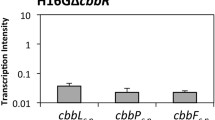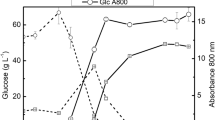Summary
In Chromatium strain 6412 storage carbohydrate synthesized in the light, gradually disappeared in the dark. Simultaneously, poly-β-hydroxybutyric acid (PHB) was produced, CO2 was released and intracellular elemental sulfur was reduced to sulfide. Expressed on a molar base, the ratio between storage carbohydrate monomer (as glucose) consumed, sulfur reduced, PHB monomer produced, and sulfide released was approximately 1 : 3 : 1 : 3. This indicates that sulfur acts electron acceptor in the conversion of storage carbohydrate to PHB. Assuming that in the dark storage carbohydrate is broken down to pyruvate via the Embden-Meyerhoff pathway, whereafter PHB is synthesized from pyruvate via acetyl-CoA and acetoacetyl-CoA, the conversion of storage carbohydrate to PHB results in a net gain of 3 ATP per glycosyl unit converted. Since Thiorhodaceae are photolithotrophs, these processes would provide the organisms with maintenance energy during dark periods. They also explain motility of Chromatium in the dark.
Similar content being viewed by others
References
Dawes, E. A., and D. W. Ribbons: Some aspects of the endogenous metabolism of bacteria. Bact. Rev. 28, 126–149 (1964).
Gemerden, H., van: Growth measurements in Chromatium cultures. Arch. Mikrobiol. 64, 103–110 (1968a).
—: Utilization of reducing power in growing cultures of Chromatium. Arch. Mikrobiol. 64, 111–117 (1968b).
Hendley, D. D.: Endogenous fermentation in Thiorhodaceae. J. Bact. 70, 625–634 (1955).
Latimer, W. M.: The oxidation state of the elements and their potentials in aqueous solutions. New York: Prentice-Hall, Inc. 1938.
Roelofsen, P. A.: On photosynthesis of the Thiordodaceae. Thesis, Univ. Utrecht 1935.
Stanier, R. Y., M. Doudoroff, R. Kunisawa, and R. Contopoulou: The role of organic substrates in bacterial photosynthesis. Proc. nat. Acad. Sci. (Wash.) 45, 1246–1260 (1959).
Trüper, H. G., and H. G. Schlegel: Sulphur metabolism in Thiorhodaceae. I. Quantitative measurements on growing cells of Chromatium okenii. Antonie v. Leeuwenhoek 30, 225–238 (1964).
Van Niel, C. B.: On the metabolism of the Thiorhodaceae. Arch. Mikrobiol. 7, 323–358 (1936).
Author information
Authors and Affiliations
Rights and permissions
About this article
Cite this article
van Gemerden, H. On the ATP generation by Chromatium in darkness. Archiv. Mikrobiol. 64, 118–124 (1968). https://doi.org/10.1007/BF00406970
Received:
Issue Date:
DOI: https://doi.org/10.1007/BF00406970




